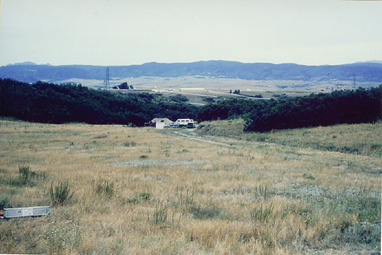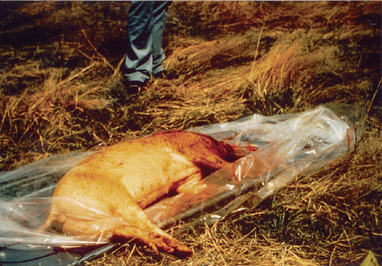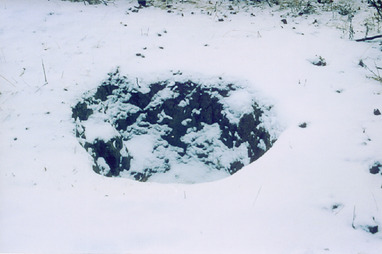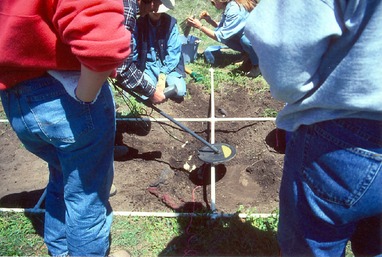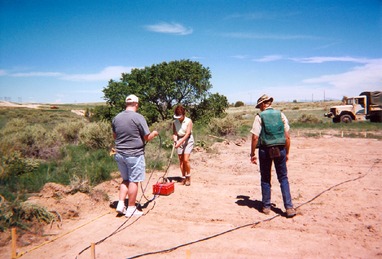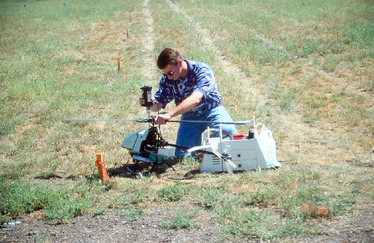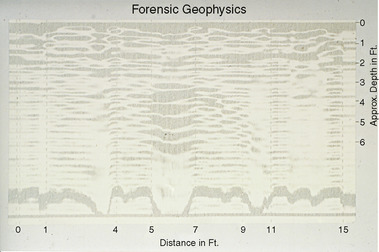CHAPTER 22. Taphonomy, NecroSearch, and Mass Grave Exhumation
Deborah Storlie and John R. McPhail
This chapter explores how the application of taphonomy principles helps investigators to discover the truth about the events leading to the suspicious death of victims found in clandestine graves. Throughout the international community, there are reported incidents of human atrocities. These atrocities range from single-victim crimes to mass genocides. Often victims and evidence related to the human rights violations are buried in a clandestine grave. A clandestine grave “represents an intrusion into the natural and/or ambient environment” (www.necrosearch.org, 2009).
Science of Taphonomy
Taphonomy is the study of the fate of human remains after death (Haglund & Sorg, 1997). A vivid imagination is required to entertain all of the physical, environmental, and circumstantial possibilities that might alter a body that has been hastily abandoned in the woods or buried in a shallow grave as opposed to one that received a contemporary burial when the body is carefully prepared, perhaps embalmed, protected in a sealed casket and vault, and placed into the ground or mausoleum crypt. As Haglund noted, at clandestine gravesites, the body influences the surroundings as much as the surroundings influence what happens to the body (James & Nordby, 2005). This dynamic interaction can assist medical death investigators in determining when the body was deposited at a given location and whether or not it has been moved, be it by criminal design or by the acts of nature, animal scavengers, or other natural forces.
Taphonomy in the forensic context
Taphonomy was developed within the disciplines of paleontology, archaeology, and paleoanthropology (Haglund & Sorg, 1997). Forensic taphonomy focuses on reconstructing events at and following death. This is done through collection and analysis of data, distinguishing perimortem and postmortem alteration of remains, estimating how long the remains have been at the site, and estimating time of death.
Grave locations
Human remains may be encountered in mountains, glaciers, deserts, rain forests, and farm fields, and it is imperative to answer questions about what happened to the body before death, at the time of death, and after the remains ultimately reached a final resting place. Each of these sites is likely to produce important information regarding the length of time since death and how body decomposition and dispersal has been affected by the unique environmental characteristics of each locale. The taphonomist, working with other forensic investigators, is better able to answer these questions after having studied similar scenarios where known characteristics can be matched. However, some of these case findings are so unique that little or no prior information is known about the normal processes of decomposition and disarticulation in that given location.
The increasing importance of such knowledge was the stimulus for the origination of NecroSearch International, Inc., a nonprofit, volunteer organization dedicated to research, education, and investigation in the location of clandestine graves, the recovery of the remains, and the investigation of associated evidence in and around the graves (France, Griffin, Swanburg, et al., 1997). Volunteers consist of individuals from law enforcement, investigations, serology and chemistry, forensic nursing, forensic anthropology, archaeology, entomology, geology, pedology, geophysics, geochemistry, petrology, photography and aerial photography, thermal imagery, meteorology, botany, wildlife biology, and criminal psychology. Naturalists and computer data analysts are the other valuable personnel associated with the project. Scent-detecting dogs and their handlers, as well as other outside resources, may be obtained as needed in certain phases of the project studies.
History of taphonomy
The concept of utilizing scientific techniques in locating clandestine graves originated in 1987 by a group of law enforcement investigators and scientists who were frustrated by conventional grave location methods such as large-scale ground searches and trial-and-error excavations employing heavy equipment (France et al., 1992, Haglund et al., 1990 and Imaizumi, 1974). In 1986, law enforcement originated a search on a 2200-acre ranch located approximately 30 miles west of the Kansas border near Stratton, Colorado. According to information provided by an informant, up to a dozen bodies had been buried in an area of several square kilometers over the course of several years. Three bodies were unearthed and recovered through the use of backhoes, which unfortunately destroyed not only the crime scene but also much of the evidence. The remaining area was then arbitrarily trenched and plowed as investigators searched for further remains but turned up none. Because of the destructive and intrusive methods used in the search, further detection utilizing scientific methods proved ineffective. It was then and is still believed that additional bodies remain undiscovered on the property.
Because of the limitations found with traditional methods in the location and excavation of clandestine graves, the basis of the NecroSearch research began with Project PIG (“Pigs in Ground”). In 1988, a study of the relationships between buried pig carcasses and their surroundings was implemented using various techniques from the scientific community and applying the results to actual cases of buried human remains. The multidisciplinary project involved law enforcement agencies, scientists, private businesses, and academicians (France, et al., 1992). The information gained in this research had traditionally been obtained separately if at all. It should be noted that there is no singular technology that can determine if a body is buried beneath the surface; however, a compilation of all the techniques can identify a particular site or number of sites that are the most likely to be the location of a clandestine grave. In the same vein, compiling these techniques may also determine that there are no disturbances beneath the surface in a given area, saving time and unnecessary excavations (Hoving, 1986 and Killam, 1989). Success is not always measured in recovery of remains, but sometimes in knowing where not to dig.
Research strategy
Pigs were originally used for burial at the research site, and they continue to be used for the following reasons. First, Colorado law does not allow human cadavers to be used for these types of studies. Second, pigs have a fat-to-muscle ratio similar to humans, and their skin is not heavily haired. The pigs used in this research were similar to humans in weight (70 kg/154 pounds), although some smaller pigs were included to simulate bodies of different ages or sizes. Third, pigs have been previously used in studies of patterns and rates of decay and scavenging because they have been considered to be similar to humans biochemically as well as physiologically.
The site of the original NecroSearch project was approximately 20 miles south of Denver, Colorado, on the Highlands Ranch Law Enforcement Training Facility property (Fig. 22-1). The site was selected because it offered proximity to human and physical resources and yet had strict operating procedures and security barriers to control public access. Baseline data, including a series of black-and-white aerial photographs, geophysical measurements, and environmental observations of the site, were carefully recorded before the burial of the first pig. Aerial photography is the least destructive method, because it is virtually nonintrusive. It provides an excellent characterization of a particular site, including the access, culture, drainage, and topography. In addition, an extremely large area can be covered in a relatively short time. Preburial photographs may be available from a variety of sources including the U.S. Geological Survey (USGS), county planning boards, utility companies, and railroads.
Baseline data
Near-field factors (i.e., interacting with the burial system) and far-field factors (i.e., uninfluenced by the burial system) were recorded before and after the burial of each pig carcass to appreciate physical site disturbances associated with the burial processes (Fig. 22-2). Other research components included calibration pits (graves without an interred pig) and a control site (undisturbed at both the surface and the subsurface). The latter site is necessarily remote from where pigs have been interred. The back dirt (i.e., excess soil deposited near the perimeter of the grave or calibration pit) serves as a valuable marker of gravesites, useful even with aerial photography used to identify near-field characteristics. Vegetation growth patterns, soil markings associated with excavational boundaries, and snow settled in grave depressions were phenomena visible from the air. Because an extended period must elapse before the gravesite returns to its original state, pig burial sites continue to be monitored and photographed on a regular basis. Climatic conditions, seasonal changes, and freezing/thawing cycles affect soil properties and change the land’s appearance when viewed from the air (Fig. 22-3). The best aerial photographs result from using a large film format, which allow investigators to fully appreciate the details of vegetative or terrain changes.
Environmental markers
Researchers prepared a list of all plants within the law enforcement training site including all plants growing on graves, calibration pits, and back dirt areas. When a grave has been created and a body buried, certain vegetation is destroyed and secondary successions are set into motion (Bass & Birkby, 1978). Five years after the pig burials, it was noted that undisturbed plots contained the greatest diversity in plant species, both weeds and wild flowers. After burials, the plots showed little species diversity. Although eventually other species invaded from the surrounding undisturbed areas, plots did not recover the plant mixture that they originally possessed. It should be noted, however, that even in graves that no longer contained pigs because of intentional disinterment or animal scavenging, revegetation characteristics were identical to those that still contained a pig. Warmth associated with a decaying pig in the ground and the presence of certain nutrients added to the soil did not seem to support or inhibit plant growth. It is evident from the NecroSearch findings that knowledge of native plants in an area can provide valuable clues to the site of a clandestine grave, particularly where the vegetation is largely otherwise undisturbed.
Burial of a corpse hinders the normal faunal succession of arthropods, many of which are useful as forensic indicators (Smith, 1983). Control sites with traps were created to study airborne and surface insects at 1, 2, 4, 7, 12, 25, and 30 days post-pig burial. There were no readily visible entomological indicators of the buried pigs, such as surface stains from saponification or liquefaction 30 days after the burial. The blowfly ( Calliphora vomitoria) was noted in the Malaise trap within 24 hours of burial, and Phormia regina arrived 48 hours postburial. In two weeks, significant numbers of blowflies were trapped at the active graves compared to control sites. Pit traps did not capture any arthropods, typically considered to be forensic indicators (Payne, King, & Beinhart, 1968).
Assets and limitations of detection tools
When searching for clandestine graves, the team must consider many factors when choosing tools and other resources to aid in their work. The place, weather, and season are just a few of the factors that must be carefully considered. Methods used to detect clandestine graves include aerial photography, geology, botany, entomology, geophysics and magnetics, electromagnetics, ground penetrating radar, self-potential, soil gas, metal detection, thermal imagery, decomposition dogs, naturalists, archaeologists, and forensic physical anthropologists. The methods selected to aid in the search efforts maximize the team’s efforts and minimize any impact on the environment.
Many methods are considered advantageous because they are nonintrusive; however, often these methods can also be limiting. For example, ground-penetrating radar is nonintrusive, yet it is limited because the equipment is difficult to obtain. In the same way, a metal detector is relatively nondestructive and nonintrusive and can easily detect bullets, jewelry, and other metallic objects (Fig. 22-4). However, this method assumes there is metal on the body.
Mass Graves
NecroSearch International has combined scientific research and the science of taphonomy to provide the international community with tools to utilize in locating clandestine graves. These pressure tested methods are becoming increasingly beneficial as the search and discovery of mass graves gains global attention.
Bodies are buried in mass graves for a number of reasons. Governments may use mass graves following natural disasters out of necessity to contain disease. Other mass graves contain victims and evidence of human rights abuses. Per the United Nations (UN), around the globe, extralegal, arbitrary, and summary executions include (1) political assassinations, (b) deaths resulting from torture or ill-treatment in prison or detention, (3) deaths resulting from enforced “disappearances, (4) deaths resulting from the excessive use of force by law-enforcement personnel, (5) executions without due process, and (6) acts of genocide. In the majority of cases, mass graves are a method used to dispose of and hide remains. Forensic experts are often called on to exhume the bodies and to make positive identifications. In cases of human rights abuses, forensic experts are also solicited to determine the chronology of events leading to death for the purpose of bringing the perpetrators to justice and preventing similar events from occurring. Often these killings are deliberate, unlawful, and politically motivated. These deaths are considered homicides (Kirschner & Hannibal, 1994).
The United Nations has accepted the definition of mass graves as “locations where three or more victims of extra-judicial, summary or arbitrary executions were buried, not having died in combat or armed confrontations.” (United Nations: ICTY) The intent of conducting mass grave exhumations is to corroborate witness testimony, to recover evidence related to reported events of wrongful death, to document injuries, and to recover human remains.
Mass gravesites can support witness testimony and provide irrefutable evidence that crimes such as summary executions were committed. John Gerns, forensic expert of the United Nations’ International Crime Tribunal for the former Yugoslavia (ICTY), stated, “Regardless of the reliability of the witness, testimonial evidence without corroborating physical evidence can be the most contentious and weak form of evidence in an investigation or during the subsequent trial” (United Nations: ICTY).
Postmortem examinations are generally done for the purpose of determining the cause and manner of death and to collect and record data to aid in the identification of mortal remains. (Skinner, Alempijevic, & Djuric-Srejic, 2003).
Mass grave exhumations have been called “a milestone in the rendering of international justice” (United Nations: ICTY, no date). Before the 1980s, documentation of human rights abuses was almost entirely through witness and victim testimony. From 1984 to 1985, forensic scientists from the United States, working under the auspices of the American Association for the Advancement of Science, exhumed skeletal remains for identification of disappeared persons in Argentina. “It became apparent that medical and forensic verification of torture and extra-judicial executions could provide irrefutable evidence that such activities had taken place” (United Nations: ICTY, no date). Such missions have been conducted in more than 30 countries including Bosnia-Herzegovina, Kosovo, El Salvador, and Guatemala, to name only a few.
Consulting Scientists in Death Investigation
Several types of scientists may be enlisted to assist the forensic medical examiner in determining the cause and manner of death when the death has been recent and the identity of the individual is known. However, when a partially decomposed body or skeletal remains are discovered in a remote area or at a clandestine gravesite, new questions arise that mandate the use of additional experts, including forensic anthropologists, archaeologists, botanists, naturalists, and climatologists. Anthropologists can be very helpful in answering certain questions, such as the following:
• Are the bones from an animal or a human?
• If human, what is the approximate age, race, gender, and stature of the individual?
• Have scavenging animals disarticulated the body or damaged bones?
• If there are defects in the body assemblage, were they caused by premortem or postmortem events?
• What effects have plants, animals, weather, and climate had on the body over time?
In some instances, archaeologists will be involved in distinguishing contemporary burials from ancient ones. When the geological period of the burial site is in question, paleontologists are consulted. Botanists, naturalists, climatologists, and geologists can also help to answer many questions for forensic death investigators.
Stages of Exhumation
Mass grave exhumations involve many partitioned activities that can be grouped into four stages. Each calls on the skills of the experts described earlier. Forensic nurse examiners (FNEs) offer knowledge and skills that complement or expand on those of other forensic professionals. Forensic nurses can be utilized in the field and can be a valuable asset throughout the entire exhumation process and postexhumation analysis. Therefore, forensic nurses interested in this activity should present their skills and training to groups such as Physicians for Human Rights and make a place for themselves in the exhumation process.
The first stage is the identification and exhumation of a gravesite using forensic recovery methods. Following the careful, well-planned exhumation of the remains, the second stage, postmortem identification, is attempted using a variety of techniques. Autopsy and laboratory results, along with investigation reports, then allow for reconstruction of the crime scene and the criminal activities leading to death. This is the third stage. The ultimate goal, and final stage, is the identification and prosecution of the perpetrator(s). This chapter discusses the primary issues encountered at each stage, emphasizing the role of the FNE in contributing to the success of the mission. The four stages allow the forensic investigation team to discover the truth about the events leading to the suspicious death of victims in mass graves by seeking to answer, at a minimum, the set of questions outlined in Table 22-1, as defined in the United Nations Manual on the Effective Prevention and Investigation of Extra-Legal, Arbitrary and Summary Executions, U.N. Doc. E/ST/CSDHA/.12 (1991).
| *United Nations Manual on the Effective Prevention and Investigation of Extra-Legal Arbitrary and Summary Executions, U.N. Doc. E/ST/CSDHA/.12 (1991) | |
| Purpose of an Inquiry | Related Stage of Mass Grave Exhumation |
|---|---|
| To recover and preserve evidentiary material related to the death to aid in any potential prosecution of those responsible | Stage 1 |
| To identify possible witnesses and obtain statements from them concerning the death | Stage 1 |
| To identify the victim | Stage 2 |
| To determine the cause, manner, location, and time of death, as well as any pattern or practice that may have brought about the death | Stage 3 |
| To distinguish between natural death, accidental death, suicide, and homicide | Stage 3 |
| To identify and apprehend the person(s) involved in the death | Stage 4 |
| To bring the suspected perpetrator(s) before a competent court established by law | Stage 4 |
Regardless of the circumstances of exhumation, a chain of custody must be followed for recovered evidence to be admissible at trial. Clyde Snow, the world-renowned forensic anthropologist, emphasized the gravity of the forensic examiner role while exhuming a mass grave in Vukovar, Croatia: “Lose one tooth or even a foot bone and you’re an accomplice to the crime” (Stover, p. 14, 1997).
The greatest injustice that can be done to the wrongfully executed and their family, second only to ignoring evidence, is the improper collection of evidence so as to make it inadmissible in court. Mass graves exhumed by formal forensic teams are exhumed for forensic reasons relating to prosecution charges. Additionally, local governments may conduct exhumations for the primary purpose of identification of missing and disappeared persons. The importance of standards for proper investigation into all cases of suspicious deaths has been formally recognized since 1988.
The physical exhumation usually takes about a month, depending on the number of bodies to be exhumed and extraneous circumstances. According to Federal Bureau of Investigation (FBI) special agent Tom O’Conner, who worked with teams in Kosovo to exhume mass graves, “on average a team of 8 or 9 investigators can exhume 5 or 6 bodies a day” (Lumpkin & Chang, 2002). The forensic and pathological examinations require considerably more time.
The very existence of mass graves, alone, does not provide proof of criminality because many possible explanations may exist for their creation. Plagues, famine, and mass disaster in Third World countries all produce dangerous health situations that demand the rapid mass burial of victims to prevent further deaths from disease.
Stage 1: exhumation strategies and forensic recovery methods
Primary Issues
Before beginning exhumation, preparatory work must be completed. This involves two stages: (1) searching for the site, and then (2) preparing the site for exhumation. Searching for the site is often the first of many challenges. Investigation begins before exhumation is started through interviews with witnesses and a detailed survey of the area. The crime scene investigators incorporate witness statements, previous investigative and casualty data reports, alterations to the landscape, and evidence distribution to determine the area most likely to contain human remains (Hoshower, 1998). At times, the local government is asked to inform investigators of mass grave locations. Satellite photographs are also used to locate areas of disturbed earth and vegetation (Hoshower, 1998). Those trying to locate a mass burial site also rely on infrared film to detect heat emitted from a decomposing body as tissue begins to rot. The gravesite should be identified and treated as a crime scene where homicides took place. This includes any location where physical or trace evidence may be found. Electronic mapping procedures precisely measure and map the entire grave area.
Searching for the Site: Evaluation Tools
Many methods, strategies, and resources are used to assist in detecting clandestine graves. They include photography; interpretation of the environment through geological, geophysical, botanical, and entomological sciences; and thermal imagery (Figs. 22-5, 22-6 and 22-7). Additional evaluation strategies include team augmentation using decomposition or scent-detecting dogs and the consultation of additional personnel, such as naturalists, archaeologists, and forensic physical anthropologists.
Geophysical
Three specific geophysical tools have been proven most useful to identify the location of a clandestine gravesite: magnetics (MAG), electromagnetics (EM), and ground-penetrating radar (GPR). These geophysical tools can be efficiently run using portable equipment (Davenport, Lindemann, Griffin, et al., 1998). Portable computers in the field can be used to gather and store MAG and EM survey data for presentation as contour maps or individual profiles. Real-time GPR data are acquired in real-time formats and can be used immediately by field investigators. EM surveys have proven to be more useful than MAG surveys because the ground conductivity changes over graves as a result of the increased porosity of the backfill materials. EM surveys may be used to determine changes in ground conductivity and to detect ferrous and nonferrous metals in the soil. A GPR survey, however, seems to be the most useful method for finding and delineating gravesites because expert GPR technicians can readily identify soil changes and excavation patterns. Enhancements provided by color monitoring of the GPR systems allow investigators to easily identify changes in soil horizons over actual gravesites (Sheriff, 1983).
Soil Gas
A soil gas survey performed at the research site can be a useful technique for locating graves. However, this technique is labor intensive. Background levels of methane and other volatile compounds must be determined for the entire research site, and near-field readings must be taken directly over graves and calibration pits. Certain soil types and above-freezing temperatures provide the most favorable results when using gas surveys (Kelly, 1989).
Thermal Imagery
Far-field thermal imagery of steady-state and dynamic scenes can be obtained by panning the camera across the terrain of the research site; aiming the camera toward and fixing it on each grave and calibration pit provides near-field information for researchers. Aerial photography combined with infrared photography (forward-looking infrared, or FLIR) has been successfully used in searches for buried bodies (Dickinson, 1977). A FLIR system offers high resolution but requires a truck mount. Experts believe that the use of infrared should not be limited to detecting heat-related changes associated with decomposition. It is also valuable for detecting compaction or density differences between the disturbed and undisturbed ground, and therefore it can be used to detect gravesites, even years after heat-generating decomposition has ceased (McLaughlin, 1974).
Scent-Detecting Dogs
The use of scent-detecting dogs or decomposition dogs, more commonly known as “cadaver dogs,” is relatively nondestructive. Dogs can be effective over water as well as on land. Bloodhounds are often used because of their keen sense of smell. They are an excellent resource for locating bodies, whether above ground, buried, or even underwater. The dogs are tethered to a 15-foot lead, working over zigzag patterns downwind from a suspected area until the animal “alerts” to a scent. At this point, the dog is allowed to work its own search pattern to the source. Note that the parameters for far-field and near-field investigations are essentially defined by the animal itself.
The utility of scent-detecting or decomposition dogs is limited by high temperatures (temperatures above approximately 29°C, or 85°F) because of general animal discomfort; limitations are also imposed by extremely low temperatures, and in such conditions the dog must be within one meter to locate the source. Optimal conditions for the successful use of scent-detecting dogs include temperatures between approximately 4° and 16°C (40° to 60°F), 20% or higher humidity, moist or very moist ground, and a wind speed of at least 8 km (5 miles) per hour (Galloway, Birkby, Jones, et al., 1988). No upper limit for wind speeds has been established, although the scent cone becomes quite narrow and more difficult to detect with higher wind speeds. Meteorologists are helpful members of the team in determining optimum times for the dogs to be used.
Based on prior experience using scent-detecting dogs, researchers have found the trained animal will indicate the presence of decayed human scent when human blood, feces, urine, and other organic compounds are noted. Other materials that have been handled or worn by humans will also give rise to a false positive indication.
Tests are being devised to determine the maximum time since death in which dogs can detect decomposition scents, because some decomposition dogs have identified archaeological remains that are 1400 years old. Ordinarily, they have been recognized as successful in locating decomposed human tissue scents more than 170 years postburial (Hunter, 1994).
Upon recognition of a possible mass grave, aerial photographs should be taken of the area before disturbing the landscape (similar photographs should be taken at the completion of exhumation for comparison). Using a T-shaped steel rod and a probe to detect methane gas and measure temperature is useful when a possible gravesite is discovered. The use of these techniques prevents unnecessary excavation at all suspected sites, which can be costly and time consuming (Boyd, 1979). Additionally, investigators must differentiate mass graves related to conflicts from those dating back to conflicts in the same territories during previous periods of violence (e.g., World War II). It is also important to distinguish between graves of combatants or civilians who were buried collectively for the purpose of sanitation or for logistical reasons.
Stay updated, free articles. Join our Telegram channel

Full access? Get Clinical Tree


Get Clinical Tree app for offline access

